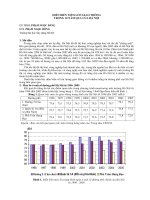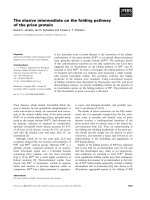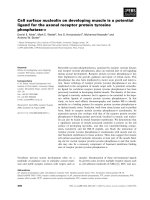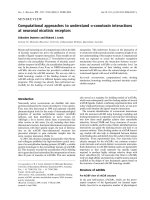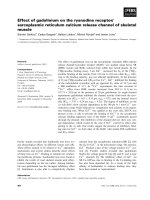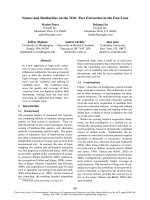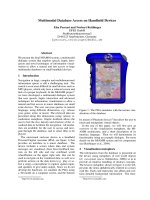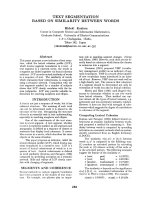Báo cáo khoa học: "Computational Linguistics Research on Philippine Languages" pdf
Bạn đang xem bản rút gọn của tài liệu. Xem và tải ngay bản đầy đủ của tài liệu tại đây (13.42 KB, 2 trang )
Computational Linguistics Research on Philippine Languages
Rachel Edita O. ROXAS
Software Technology Department
De La Salle University
2401 Taft Avenue, Manila, Philippines
Allan BORRA
Software Technology Department
De La Salle University
2401 Taft Avenue, Manila, Philippines
Abstract
This is a paper that describes computational
linguistic activities on Philippines
languages. The Philippines is an archipelago
with vast numbers of islands and numerous
languages. The tasks of understanding,
representing and implementing these
languages require enormous work. An
extensive amount of work has been done on
understanding at least some of the major
Philippine languages, but little has been
done on the computational aspect. Majority
of the latter has been on the purpose of
machine translation.
1 Philippine Languages
Within the 7,200 islands of the Philippine
archipelago, there are about one hundred and
one (101) languages that are spoken. This is
according to the nationwide 1995 census
conducted by the National Statistics Office of
the Philippine Government (NSO, 1997). The
languages that are spoken by at least one percent
of the total household population include
Tagalog, Cebuano, Ilocano, Hiligaynon, Bikol,
Waray, Pampanggo or Kapangpangan,
Boholano, Pangasinan or Panggalatok, Maranao,
Maguin-danao, and Tausug.
Aside from these major languages, there are
other Philippine dialects, which are variants of
these major languages. Fortunato (1993)
classified these dialects into the top nine major
languages as above (except for Boholano which
is similar to Cebuano).
2 Language Representations
Linguistics information on Philippine
languages are extensive on the languages
mentioned above, except for Maranao, Maguin-
danao, and Tausug, which are some of the
languages spoken in Southern Philippines. But
as of yet, extensive research has already been
done on theoretical linguistics and little is
known for computational linguistics. In fact, the
computational linguistics researches on
Philippine languages are mainly focused on
Tagalog.
1
There are also notable work done on
Ilocano.
Kroeger (1993) showed the importance of the
grammatical relations in Tagalog, such as
subject and object relations, and the
insufficiency of a surface phrase structure
paradigm to represent these relations. This issue
was further discussed in the LFG98, which is on
the problem of voice and grammatical functions
in Western Austronesian Languages. Musgrave
(1998) introduced the problem certain verbs in
these languages that can head more than one
transitive clause type. Foley (1998) and Kroeger
(1998), in particular, discussed about long
debated issues such as nouns in Tagalog that can
be verbed, the voice system of Tagalog, and
Tagalog as a symmetrical voice system.
Latrouite (2000) argued that a level of semantic
representation is still necessary to explicitly
capture a word’s meaning.
Crawford (1999) contributed to an issue on
interrogative sentences and suggested that the
restriction on wh-movement reveals the
syntactic structure of Tagalog.
Potet (1995) and Trost (2000) provided general
materials on computational morphology, though,
both presented examples on Tagalog.
Rubino (1997, 1996) provided an in-depth
analysis of Ilocano. Among the major
contributions of the work include an extensive
treatment of the complex morphology in the
language, a thorough treatment of the discourse
1
Tagalog (or Pilipino) has the most number of
speakers in the country. This may be due to the fact
that it was officially declared the national language of
the Philippines in 1946.
particles, and the reference grammar of the
language.
3 Applications in Machine Translation
Currently, most of the empirical endeavours in
computational linguistics are in machine
translation.
3.1 Filipino MT Software
There are several commercially available
translation software, which include Philippine
language, but translation is done word-for-word.
One such software is the Universal Translator
2000, which includes Tagalog among 40 other
languages. Although omni-directional, trans-
lation involving Tagalog excludes morpho-
logical and syntactic aspects of the language
Another software is the Filipino Language
Software, which includes Tagalog, Visayan,
Cebuano, and Ilocano languages.
3.2 Machine Translation Research
IsaWika! is an English to Filipino machine
translator that uses the augmented transition
network as its computational architecture
(Roxas, 1999). It translates simple and
compound declarative statements as well as
imperative English statements. To date, it is the
most serious research undertaking in machine
translation in the Philippines.
Borra (1999) presented another translation
software that translates simple declarative and
imperative statements from English to Filipino.
The computational architecture of the system is
based on LFG, which differs from IsaWika’s
ATN implementation. Part of the research was
describing a possible set of semantic information
on every grammar category to establish a
semantically-close translation.
4 Conclusion
There are various theoretical linguistic studies
on Philippine languages, but computational
linguistics research is currently limited. CL
activities in the Philippines had yet to gain
acceptance from its computing science
community.
References
Borra, A. (1999) A Transfer-Based Engine for an
English to Filipino Machine Translation Software.
MS Thesis. Institute of Computer Science,
University of the Philippines Los Baños.
Philippines.
Crawford, C (1999) A Condition on Wh-Extraction
and What it Reveals about the Syntactic Structure
of Tagalog.
/>l304final.html
Foley, B (1998) Symmetric Voice Systems and
Precategoriality in Philippine Languages. In
LFG98 Conference, Workshop on Voice and
Grammatical Functions in Austronesian
Languages.
Fortunato, Teresita, Mga Pangunahing Etnoling-
guistikong Grupo sa Pilipinas, 1993.
Kroeger, P (1998) Nouns and Verbs in Tagalog: A
Response to Foley. In LFG98 Conference.
_____ (1993) Phrase Structure and Grammatical
Relations in Tagalog. CLSI Publications, Center
for the Study of Language and Information,
Stanford, California.
Latrouite, Anja (2000) Argument Marking in
Tagalog. In Austronesian Formal Linguistics
Association 7
th
Annual Meeting (AFLA7). Vriji
Universiteit, Amsterdam, The Netherlands.
Musgrave, S (1998) The Problem of Voice and
Grammatical Functions in Western Austronesian
Languages. In LFG98 Conference.
National Statistics Office (1997) “Report No. 2:
Socio-Economic and Demographic Charac-
teristic”, Sta Mesa, Manila.
Potet, J (1995) Tagalog Monosyllabic Roots. In
Oceanic Linguistics, Vol. 34, no. 2, pp. 345-374.
Roxas, R., Sanchez, W. & Buenaventura, M (1999)
Final Report of Machine Translation from English
to Filipino: Second Phase. DOST/UPLB.
Rubino, C (1997) A Reference Grammar of Ilocano.
UCSB Dissertation, UMI Microfilms.
_____ (1996) Morphological Integrity in Ilocano.
Studies in Language, vol. 20, no. 3, pp. 333-366.
Trost, Harald (2000) Computational Morphology.
/>
